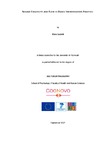Shared Creativity and Flow in Dance Improvisation Practice
| dc.contributor.supervisor | May, Jon | |
| dc.contributor.author | Łucznik, Klara | |
| dc.contributor.other | Faculty of Health | en_US |
| dc.date.accessioned | 2018-05-30T15:48:07Z | |
| dc.date.issued | 2018 | |
| dc.identifier | 10494167 | en_US |
| dc.identifier.uri | http://hdl.handle.net/10026.1/11608 | |
| dc.description.abstract |
This thesis investigated shared creative processes and the role of flow experience in group dance improvisation. A literature review suggested that dancers associate high-quality performance with 'being in the flow', and that group flow is a peak experience when a group is performing at its highest level. The first study explored the role of flow in dance creative practice and improvisation through qualitative content analysis of individual interviews with six dancers. Absorption with activity and enjoyment were themes in dancers' reports of flow. Group improvisation facilitated flow and creativity through maintaining desired focus for longer, lowering self-judgment and inspiring novel solutions. The second study investigated the occurrence of flow and its shared character within group improvisation using video-stimulated recall and questionnaire methods (n=16, 4 groups of four dancers). It showed that group flow was rather rare and it was more likely when a group had worked together for longer. Dancers reported that a group in a high-flow state engaged with a task in a more complex way, sharing, transforming and supporting each other's ideas, while low-flow groups worked more with mimicry and bodily manipulation. Dancers perceived tasks performed in a high-flow state as more creative. The third study explored the relationship between dancers' flow experience and creative outcomes from a third person perspective. A total of 203 participants (77 experts and 126 nonexperts) rated excerpts of high- and low-flow dance improvisation (five each) using Consensual Assessment Technique. Experts judged high-flow collaborations as more creative, and more coherent, technically advanced, aesthetically appealing and meaningful, however there were no significant differences in nonexperts' ratings. The fourth study explored whether synchronous arousal, measured by cross-recurrence quantification analysis of heart and breathing rate, was a physiological basis for group flow (n=8 group, 4 dancers per group). Although no relationship between synchronous arousal and flow was found, spontaneous synchronization of dancers' heart and breathing rate in improvisational group tasks was observed, unrelated to synchronized activity. Overall, the studies conducted confirmed that flow was a highly creative state for dancers, in which they performed better. The presence of others and quality of group collaboration supported the occurrence and amount of flow. However, group flow occurred rarely and was more likely when a group had worked together for longer. | en_US |
| dc.language.iso | en | |
| dc.publisher | University of Plymouth | |
| dc.rights | Attribution-NonCommercial-NoDerivs 3.0 United States | * |
| dc.rights.uri | http://creativecommons.org/licenses/by-nc-nd/3.0/us/ | * |
| dc.subject | creativity | en_US |
| dc.subject | improvisation | en_US |
| dc.subject | dance | en_US |
| dc.subject | group creativity | en_US |
| dc.subject | group flow | en_US |
| dc.subject | flow | en_US |
| dc.subject.classification | PhD | en_US |
| dc.title | Shared Creativity and Flow in Dance Improvisation Practice | en_US |
| dc.type | Thesis | |
| plymouth.version | publishable | en_US |
| dc.identifier.doi | http://dx.doi.org/10.24382/679 | |
| dc.rights.embargodate | 2019-05-30T00:00:00Z | |
| dc.rights.embargoperiod | 12 months | en_US |
| dc.type.qualification | Doctorate | en_US |
| rioxxterms.funder | Seventh Framework Programme | en_US |
| rioxxterms.identifier.project | CogNovo | en_US |
| rioxxterms.version | NA | |
| plymouth.orcid_id | 0000-0002-3015-8445 | en_US |
Files in this item
This item appears in the following Collection(s)
-
01 Research Theses Main Collection
Research Theses Main



